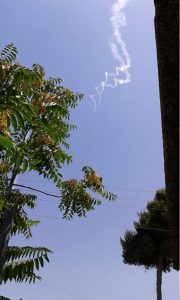
By Dan Williams and Lisa Barrington
JERUSALEM/BEIRUT (Reuters) – Israel said it shot down a Syrian warplane that crossed into the Israeli-occupied Golan Heights on Tuesday, but Damascus said the jet was fired on as it took part in operations against rebels on Syrian territory.
The incident added new fuel to weeks of tensions over the Golan, a strategic plateau between the two old enemies and where Israel has been on high alert as Syrian government forces, supported by Russia, close in to regain rebel-held ground.
For the second time in as many days, Israeli sirens sounded on the Golan and witnesses saw the contrails of two missiles flying skyward. The military said it fired Patriot interceptor missiles at a Syrian Sukhoi jet that crossed 2 km (1 mile) into Israeli-controlled airspace, after first trying to warn it off.
“It was shot down and it crashed…most likely in the southern part of the Syrian Golan Heights,” Israeli military spokesman Lieutenant-Colonel Jonathan Conricus said.
“We do not have any information so far about the pilots. I do not know of any reports of parachutes being spotted, and we do not know if any pilots have been retrieved.”
Syrian state media said, however, that a Syrian warplane had been targeted by Israel and hit while conducting raids in Syrian airspace.
“The Israeli enemy confirms its support for the armed terrorist groups and targets one of our warplanes, which was striking their groups in the area of Saida on the edge of the Yarmouk Basin in Syrian airspace,” the official news agency SANA quoted a military source as saying.

Smoke trails from two Patriot missiles can be seen near the Israeli city of Safed in northern Israel July 24, 2018. REUTERS/Stringer
An Israeli military statement appeared to acknowledge that its mission was related to the civil war next door.
“Since morning hours, there has been an increase in the internal fighting in Syria, including an increase in the activity of the Syrian Air Force,” the statement said.
It said Israel would “continue to operate against” any breach of a 1974 U.N. armistice deal that established buffer zones on the Golan.
Israel worries that Syrian President Bashar al-Assad might try to defy the demilitarization regime or allow his Iranian and Lebanese Hezbollah reinforcements to deploy near the Golan.
The raised Israeli-Syrian tensions have prompted intercession by Moscow, which sent its foreign minister, Sergei Lavrov, and top general on Monday for talks with Israeli Prime Minister Benjamin Netanyahu. Israeli officials said Netanyahu rebuffed as insufficient a Russian offer to keep Iranian forces 100 km (62 miles) from the Golan lines.
Also on Monday, Reuters witnesses on the southern edge of the Israeli-occupied Golan saw numerous warplanes and helicopters in the skies over Syrian territory.
The aircraft were dropping bombs, apparently as part of a Russian-backed Syrian government push into areas previously held by anti-government forces.
Anti-aircraft fire could also be seen, targeting the warplanes.
In February, an Israeli F-16 jet was brought down by Syrian anti-aircraft fire.
That warplane crashed in northern Israel while returning from a bombing raid on what Israel said was an Iranian military installation in Syria. Both pilots ejected and were injured, one critically.
(Additional reporting by Stephen Farrell; Writing by Dan Williams; editing by William Maclean and Angus MacSwan)